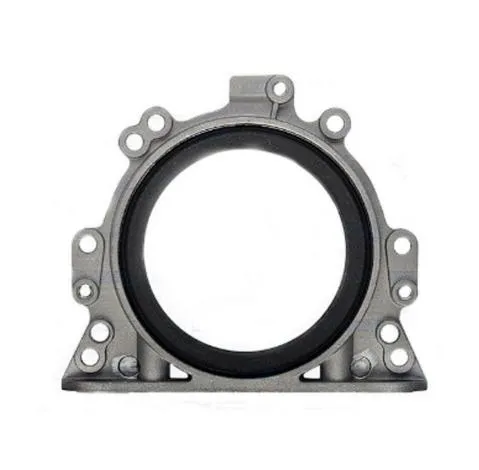The Rear Crankshaft Seal: Function, Failure Signs, and Replacement Guide
The rear crank seal is one of the most critical engine components when it comes to maintaining oil control and engine longevity. Commonly referred to by several names such as the rear crankshaft main bearing seal, rear engine oil seal, or rear main crank seal, this part plays a central role in sealing the back end of the crankshaft. In this guide, we’ll explore what it does, how to recognize failure, and what’s involved in removing the crankshaft seal for repair or replacement.

Understanding the Rear Crankshaft Seal
The rear crankshaft exits the back of the engine and connects to the transmission. To prevent oil from leaking out where the crankshaft meets the flywheel or flexplate, a seal is installed — known as the rear crank seal or rear main crank seal.
Purpose of the Seal
The rear engine oil seal performs several key functions:
Prevents engine oil from leaking at the junction between the crankshaft and transmission
Protects internal engine components by maintaining proper oil pressure
Keeps the clutch or torque converter area free from oil contamination
The rear crankshaft main bearing seal is usually made of durable rubber or polymer and is often part of a larger housing or cover that bolts onto the rear of the engine block.
Location
Sits at the back of the engine where the crankshaft exits
Hidden behind the flywheel (manual transmission) or flexplate (automatic)
Often requires transmission removal for access
Symptoms of a Failing Rear Main Crank Seal
A leaking rear main crank seal doesn’t just create a mess; it can seriously impact engine performance and health. Catching the early signs of failure can help avoid more costly repairs.
Common Warning Signs
Oil leak between engine and transmission
Oil on the underside of the bell housing
Clutch slippage due to oil-soaked clutch (manual vehicles)
Unexplained oil loss with no visible external leaks
Burning oil smell from oil dripping on exhaust parts
These symptoms typically indicate that the rear crankshaft seal is worn, cracked, or has lost its ability to seal due to age, pressure, or improper installation.
Causes of Seal Failure
Age-related wear or heat damage
Excess crankcase pressure from a faulty PCV system
Misalignment of the crankshaft
Engine oil contamination or degraded seal material
Overfilled oil causing excess pressure around the seal
Removing and Replacing the Crankshaft Seal
Removing the crankshaft seal—particularly the rear one—is not a simple job and often requires significant disassembly. However, knowing the process helps vehicle owners make informed decisions.
Step-by-Step Overview
Disconnect the battery
Remove the transmission or transaxle to access the flywheel or flexplate
Remove the flywheel or flexplate
Unbolt and remove the seal housing (if applicable)
Use a seal puller or screwdriver to carefully extract the old seal
Clean the sealing surface and inspect the crankshaft for wear
Install the new rear crank seal evenly to avoid deformation
Reassemble components in reverse order
Depending on the engine, the rear crankshaft main bearing seal may come integrated into a housing or be available as a standalone part.
Cost of Replacement
Rear crankshaft seal (part only): $20–$60
Labor cost: $400–$900+ (due to transmission removal)
Total cost: $500–$1,000 or more, depending on vehicle type
Mechanics often recommend replacing the rear crank seal during clutch jobs or transmission replacement since the labor overlaps significantly.
Tips for Success
Always replace the seal with OEM or high-quality aftermarket parts
Check for wear on the crankshaft surface
Replace the PCV valve to avoid repeated seal failure
Consider replacing the rear engine oil seal whenever the transmission is removed, even if no leak is visible yet
The rear crank seal, or rear main crank seal, may be hidden from sight, but it plays a central role in protecting your engine from oil loss and damage. Whether you’re seeing early signs of failure or planning a major engine service, understanding the location, function, and process for removing the crankshaft seal can save time, money, and potential engine wear. While replacement can be labor-intensive, it’s a necessary step in preserving engine health and reliability.
-
Simplifying Oil Changes: A Comprehensive Guide to Oil Drain Plugs and Their Variants
Iindaba Aug.04,2025
-
Mastering Oil Drain Maintenance: Solutions for Stripped, Worn, and Upgraded Oil Plugs
Iindaba Aug.04,2025
-
Fixing Oil Pan Plug Issues: Leaks, Stripped Nuts, and the Right Replacement Solutions
Iindaba Aug.04,2025
-
Everything You Need to Know About Oil Drain Plugs: Sizes, Fixes, and Upgrades
Iindaba Aug.04,2025
-
Choosing the Right Oil Drain Plug: A Guide to Sizes, Materials, and Drain Innovations
Iindaba Aug.04,2025
-
A Complete Guide to Automotive Drain Plugs: Types, Problems, and Innovative Solutions
Iindaba Aug.04,2025
-
The Ultimate Guide to Car Repair Kits: Tools and Essentials Every Driver Should Own
Iindaba Aug.01,2025
Iindidi zeemveliso















